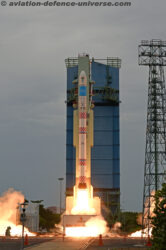By Sangeeta Saxena
New Delhi. 19 April, 2016. It is imperative to expedite the process of indigenisation in the armed forces, align this with the Make in India call, entry of the private sector into defence sector which is a game changer and Indian Navy is the trailblazer – is the take away from the two days of brainstorming in the International Seminar on ‘Make in India’ Paradigm – Roadmap for a Future Ready Naval Force. Indian Navy is on its way to becoming a 200-ship and 700-aircraft Force by 2027. The other forces can definitely learn a lesson or two from Indian Navy’s stride towards indigenisation.
“Indian Navy aspires to achieve 90% self-reliance in production of warships, in times to come all ships, submarines, aircraft and helicopters of the force will be manufactured domestically either by Indian companies or in collaboration with foreign player and the future of Indian Navy is anchored in self-reliance,” said Chief of Naval Staff, Admiral R K Dhowan .
All 46 ships and submarines, under construction, are being built in Indian shipyards, both private and public and under the Maritime Security and Perspective Plan of the Indian Navy till 2027, all Indian ships and submarines are intended to be build in India. The list lays down what will now be produced in India and not allowed to be imported. This includes multi-role helicopters, surface-to-air-missiles, early warning radars, underwater unmanned vehicles, diesel engines for warships, gas turbines, an air independent propulsion (allows submarines to stay submerged for longer periods), satellite communication system, torpedoes, night vision and advanced optics for naval pilots, towed sonars carried by warships to detect underwater submarines.
He informed that the next generation of multi-role helicopters for Indian Navy will also be manufactured through the Make in India route. As per the Navy which unveiled a 15-year plan to achieve full indigenisation in all phases of warship construction, from ship-building to systems to are all aimed at being development through the Defence Research and Development Organisation (DRDO) and Indian industry over a 15-year period.
Of the three segments the Navy has achieved 90 per cent indigenisation in the float category, 60 % in the move and 30% in the fight components.
In the ‘Move’ segment Indian Navy currently employs the three conventional propulsion modes i.e. steam plants, diesel engines and gas turbines. Sufficient developments have been made in respect to steam propulsion plants and small diesel engines. Indigenously manufactured steam turbines by BHEL and main propulsion diesels of Kirloskar Oil Engines Limited are already in use on board ships. Nuclear propulsion and integrated electric propulsion are also envisaged for future ships & submarines.
Presently all gas turbines, fitted in Naval ships are of foreign origin. There is an urgent need to develop indigenous gas turbines. Indigenisation initiatives taken in this regard include induction of General Electric’s LM 2500 gas turbine on the basis of its licensed manufacture in India with progressive increase in indigenisation. Development of a fully indigenous Kaveri Marine Gas Turbine (marine derivative of Light Combat Aircraft (LCA) gas turbine) is also being pursued at GTRE, Bangalore.
To ensure substantial indigenisation design of all machinery control systems shipbuilding programme have been evolved around open architecture standards. This has enabled indigenous availability of core hardware as well as software of machinery controls on all new construction ships. For existing ships, conversion to indigenous equivalent designs has also been planned in a phased manner. L&T has taken up indigenisation on this front.
Considerable success has been met in the development of steering gear and stabiliser systems. Systems for retrofitment for SNF and G Class ships have been successfully indigenised and installed onboard. Most of the new construction ships are being fitted with indigenous systems. Firms like L&T, Geeta Engg, Veljan Hydrair, etc., have partnered in the development of these systems.
At present shaft seals are being imported from foreign firms viz. Deep Sea Seals, UK etc. There is a need to develop a reliable indigenous gland sealing arrangement for the shafting system of the new construction ships and also for replacing the imported assemblies installed on existing ships.
The lists of components made in India and abroad is long and the aim of the Navy is to ensure that by 2030 the made abroad become made in India. India plans to develop a real blue-water navy which will dominate the Indian Ocean region but definitely needs to boost its fire power. The fight component still needs to think of major indigenisation and hopefully the Navy will plan a strategy to see that it becomes a reality, with public sector units, private industry and foreign OEMs all partnering for the cause.
Amitabh Kant CEO of NITI Ayog said for a growth of 9-10 per cent over three decades, Indian manufacturing sector needs to grow at 14-15 per cent and defence needs to be the frontrunner and defence and aerospace will be the harbinger of Make in India initiative.
Pierre de Bausset, Chairman, FICCI Committee on ‘Make in India’ (Defence & Aerospace) and President & MD, Airbus Group in India said, “Technology cannot be generated domestically overnight. A close collaboration would be required between the Indian defence sector and Foreign OEMs (Original Equipment Manufacturers), and that shall be true for a long time. Ministry of Defence (MoD) has released the new Defence Procurement Procedure (DPP) which will be a key enabler for Make in India programme.”
Advanced Navies are already making rapid strides in various associated areas towards enhancing their capabilities. The Indian Navy also needs to be the prime mover for indigenous development & early realisation of such capabilities. This assumes urgency keeping in view of the large gestation period of these and resultant ship building efforts.
































































































































